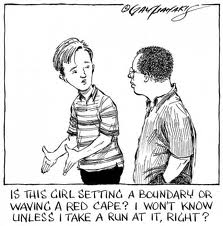The Trouble With Boundaries

It’s pretty common to hear people talk about the importance of “good boundaries.” That’s unfortunate because, while good boundaries are certainly better than bad ones, the metaphor of the boundary itself carries with it some baggage we would do well to avoid. We really can do better! Read this, and never have your boundaries violated again.
Let’s start by defining what we mean by the term. I’m not talking so much about the relatively well-defined boundaries of a therapeutic relationship, which are designed to mitigate the effects of transference and the abuse of power which might otherwise occur. (And does occur sometimes, despite that.) Instead, I’m talking about its more common usage as “personal boundaries,” which shows up in pop psychology and the glib offerings of self-help gurus. Here’s a definition that captures the gist of it:
Personal boundaries are guidelines, rules or limits that a person creates to identify for him- or herself what are reasonable, safe and permissible ways for other people to behave around him or her and how he or she will respond when someone steps outside those limits. They are built out of a mix of beliefs, opinions, attitudes, past experiences and social learning.
Personal boundaries define you as an individual, outlining your likes and dislikes, and setting the distances you allow others to approach. They include physical, mental, psychological and spiritual boundaries, involving beliefs, emotions, intuitions and self-esteem.
It’s important to acknowledge that the motivation behind having “good boundaries” is understandable, valid and very human. We all would like to be safe and happy, and having “good boundaries” seems to hold the promise of attaining what we want. Unfortunately, the concept of boundaries comes with unpleasant corollaries.
The Boundary Metaphor
Consider, first of all, that boundary refers to a concept. It’s an overlay on reality, an explanatory structure which we project on our experience as a way of understanding it and attempting to control it. Boundaries simply do not exist, in the way that say tables and trees and human beings exist. A boundary is a story we tell about relationships between things, specifically about our relationships with people. Naturally, some stories are more helpful than others. If the boundary metaphor were a helpful construct it might be good to employ it, but in fact it has some very unhelpful drawbacks.
There are two aspects to the problem. One is that with boundaries you are treating something that doesn’t exist as if it were real. Believing in an illusion is never a good start, and it’s especially harmful if you make it the foundation of your relationships. This is an instance of the reification fallacy which is really the root of the problem. People who encourage others to cultivate “good boundaries” are carelessly validating the illusion that boundaries exist, and thus contributing to the confusion!
The second issue has to do with the metaphor itself. Think of the stories we associate with personal boundaries. Those stories largely concern separation and transgression. Someone has broken a rule, exceeded a limit, impinged on our experience in a displeasing way. The crux of the boundary metaphor is the boundary violation, which implicitly creates a boundary violator and a victim of violation. Voilà! Once the boundary metaphor has been invoked, all you need to do is play your respective roles. But, trapped in a role within a metaphor, it becomes very difficult to extricate yourself. The boundary metaphor ends up solidifying roles that are inherently adversarial.
The other side of the boundary metaphor would be “boundary honorings” but they don’t seem to show up so much, probably because we don’t get triggered, or even notice, when someone meets our expectations. You may not think much about your boundary around being slapped in the face and how many people honor it, until someone actually slaps you. Then, suddenly, kapow! You’re very aware of having had the boundary and the fact that it was violated.
Boundary Mutability

Another issue with boundaries is that there is no universally accepted definition of where exactly they are. Not even close! If we have boundaries, they are unique to each of us, an amalgam of cultural, parental, social and personal custom and preference. As an example, take the kiss. The boundary you have, and how you respond depends on a myriad of factors. Is the person a stranger, a friend, a family member? Are they married or single? Is this your first date or your third? What is the duration of the kiss, and the, uh, oral aperture offered? Is your ex in the room... or your boss? What mood are you in?

Obviously, any given behavioral boundary is dependent on the particular details of the situation, and additionally can change over time. This variability should be a clue that we’re dealing with something that is not a thing—it’s a process. When you try to apply the rules that govern things to a process it’s trouble.

Given this boundary mutability, it’s impossible to know for certain what someone else’s boundaries are, thus the high probability that boundaries will be violated. The obvious solution involves communication—we’ll get to that in Part 2. For now, though, note that if you subscribe to the boundary metaphor, any unwelcome action, even if unintentional, is liable to interpretation as a boundary violation.
Paradoxically, by cultivating strong boundaries you are setting the stage to have them violated. Probably not what you intended!
Crime and Punishment
Yet another aspect of the boundary metaphor that comes into play when a boundary is violated—which is predictable and virtually inevitable—is that there are negative consequences designed to punish the violator and dissuade or prevent them from repeating their violation. Without consequences, it’s not much of a boundary. This punitive approach to relating introduces power dynamics which further erode the possibility of connection. It’s also likely to be ineffective since you probably don’t have any actual power to coerce another person’s behavior, and attempts to do so will be resisted or circumvented, leaving you worse off than before.
Invoking the boundary metaphor allows one to justify and rationalize an irrational feeling. It serves to fuel the self-righteousness of the person in the victim role. They may find the role simultaneously comforting—in its familiarity—and vexing because it inadvertently sustains an adversarial relationship.
Ultimately, this setting of strong boundaries is a manifestation of weakness, not strength—contrary to what many people believe. Imagine that you are able to respond freely, effectively, in the moment, to whatever situation life throws at you. You don’t need to have a predetermined response. This is the condition to which we should aspire. This is an unconditioned response, immediate, authentic, and uniquely suited to the particular situation in which it is made.
Projection
So far we’ve been talking more about external boundaries, that is, the projection of the internal boundary onto the external world. Internally a boundary is like a patterned response, a mostly unconscious fragment of behavior concerned with how we evaluate what is acceptable and what is not, and how we respond. When X happens, do Y. There is also a projection into the future of one’s current resolve to make a more conscious choice, to cultivate a new habit, to write a new script. This is not entirely a bad thing. Awareness of your existing habitual patterns is beneficial. And rehearsing a desired behavior prepares you to enact it. The more behaviors you have at your disposal the better! In Radical Improv we deliberately create scenarios in which we can experiment with alternative behaviors to widen our repertoire, so to speak. But where we’re ultimately headed is spontaneous, unscripted and authentic responses. Habits, even good ones, interfere with the freedom and immediacy of connection that is possible between human beings.
Projecting the internal habit of boundary onto the external world (other people) causes conflict since the reality of the external world does not correspond to the habitual patterns we’ve created in our attempt to control it. Remember, boundaries don’t exist! Having boundaries, and the expectation that other people will respect them, is simply unrealistic. It’s a recipe for conflict and disappointment.
(End of Part 1)
In Part 2 we’ll look at alternative ways of framing our interactions so that that we get the safety, love and respect we want by replacing the boundary metaphor with something better.
